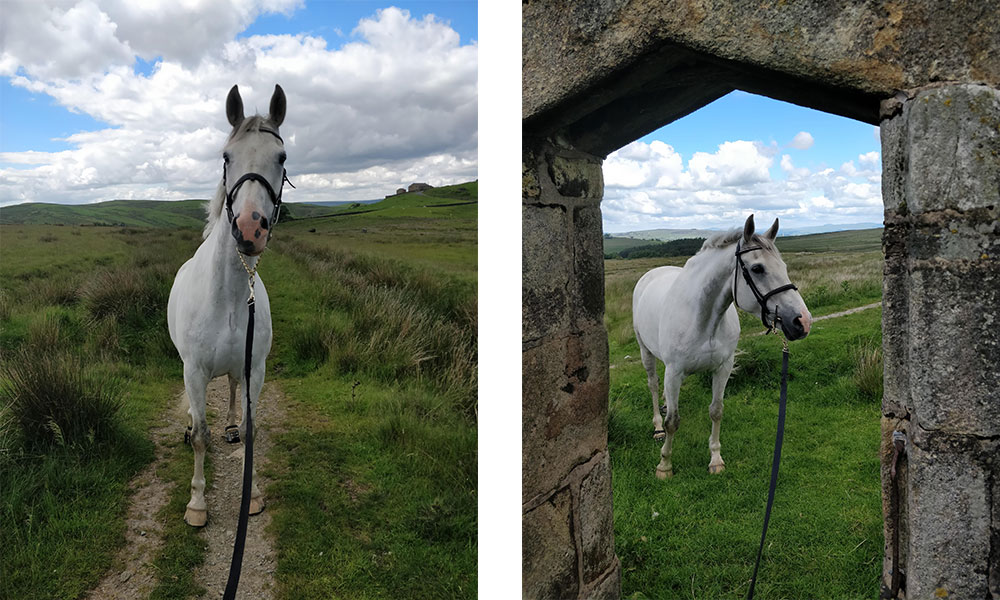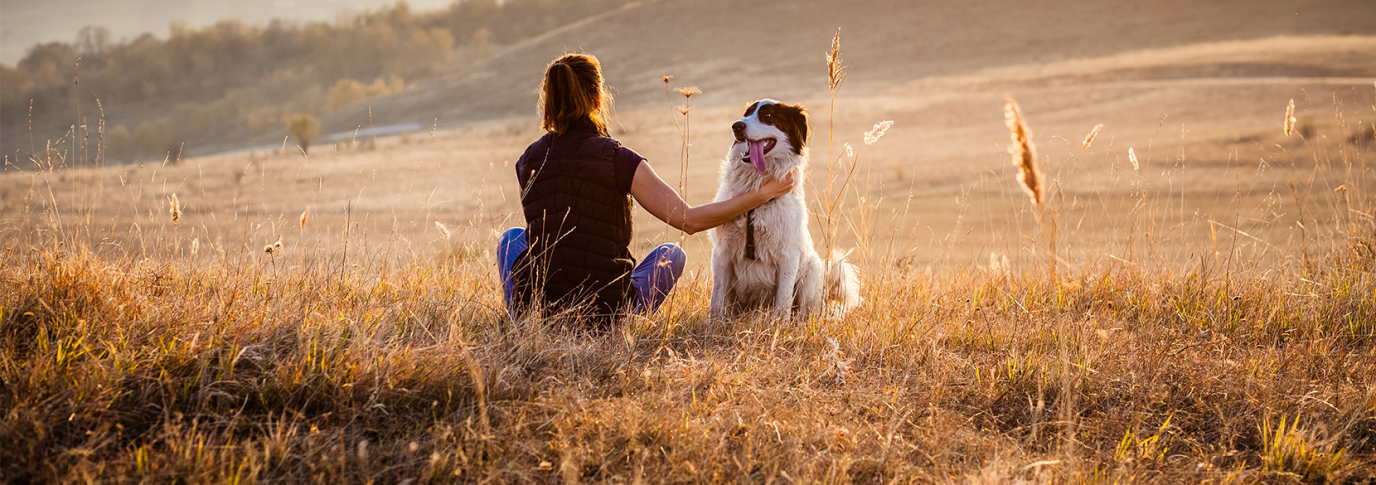Where to ride a horse
OS Champion, Charlotte Ditchburn from the British Horse Society, explains where you can ride a horse and how to plan horse riding routes near you.
The view between the ears is certainly the best way to see the countryside if you like horses. From exploring upland hills in Scotland to hidden lanes in East Anglia, horse riding and carriage driving are two perfect ways to explore these spectacular places.

A family horse ride
The benefits of horse riding are immense. It can help you physically, psychological and socially which has been shown in research undertaken by Brighton University and The British Horse Society (BHS). Being outdoors and in contact with nature are important motivations for the vast majority of horse riders.
Where to ride a horse
Knowing where you can ride a horse and drive a horse-drawn carriage is a great place to start planning your four-legged adventure. Under the Land Reform (Scotland) Act 2003, horse riders and carriage drivers enjoy as equal rights of access as walkers, cyclists and other non-motorised users to most land and inland water, day or night, provided that they exercise their rights responsibly. In England and Wales there are routes that horse riders and carriage drivers have a legal right to use called public rights of way. You can also ride on some commons, cycle routes, designated horse riding routes in public open spaces, concessionary or permissive routes, beaches and estuaries (subject to bylaws and conservation restrictions), agri-environment schemes (‘Countryside Stewardship’) and via permits and toll rides. There are lots of options!

Cumbria Heavy Horses
When planning a route in the countryside, you should bear in mind the following:
• Steep slopes – your horse will need to negotiate steep uphill and downhill gradients confidently and comfortably. Coming downhill can often be more challenging, so you may prefer to get off and lead.
• Terrain – some tracks may be stony, so consideration for your horses’ feet is required. Do they need to be shod or wear hoof boots?
• Water – is your horse confident through water? You may encounter fords, streams and shallow river crossings.
• Bridges – you might need to ride or lead over bridges.
• Gates – there may be gates on your route, so make sure you and your horse can negotiate them safely. Remember – heels to hinges.
• Surfaces – very stony ground, rock slabs and loose scree can be difficult to ride over. Lead your horse in-hand if required.
• Weather – check the forecast before you set out. High winds can make riding difficult, and poor visibility can impact your sense of direction. If you are caught out by deteriorating conditions, it can be safer to return the way you came.
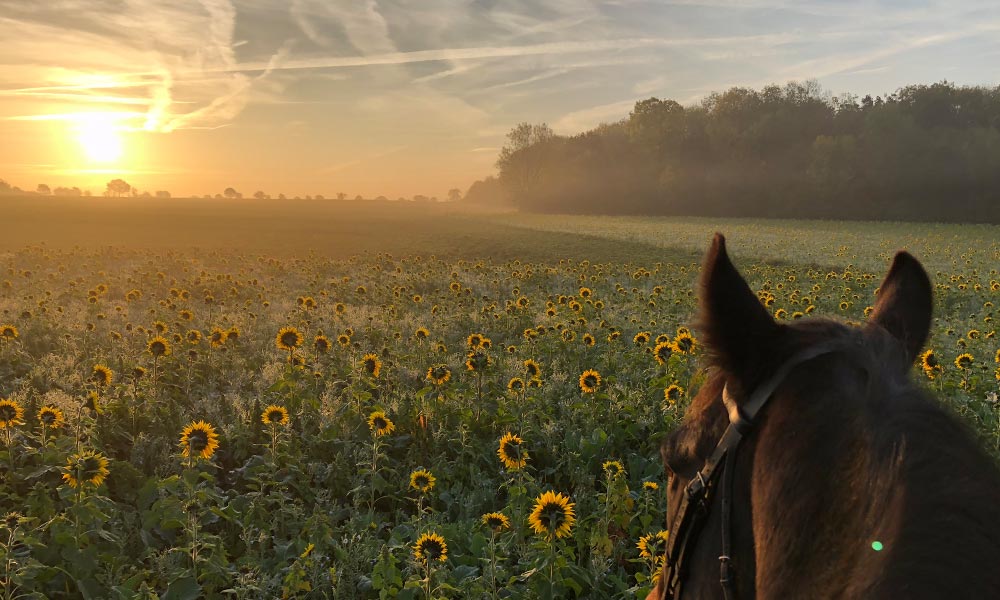
A beautiful ride through sunflowers
Planning your own route
There is a great network of public rights of way in England and Wales to take advantage of with your four-legged friends. When looking at an OS Map (premium topo or paper map) you should be looking for the below to horse ride and carriage drive on:
- Bridleways – ridden horses, horses in hand
- Restricted byways – ridden horses, horses in hand, horse-drawn carriages
- Byway Open to All Traffic (BOAT) – ridden horses, horses in hand, horse-drawn carriages
- Other Routes with Public Access (ORPA) – usually ridden horses, horses in hand and horse-drawn carriages. The exact nature of the rights on these routes and the existence of any restrictions may be checked with the local highway authority.
If you’re looking for a multiday adventure then promoted routes are shown using diamonds, they are usually more than a day’s ride, ideal for a holiday with your horse.
Familiarise yourself with what everything means on an OS Maps in this guide to map symbols and public rights of way.
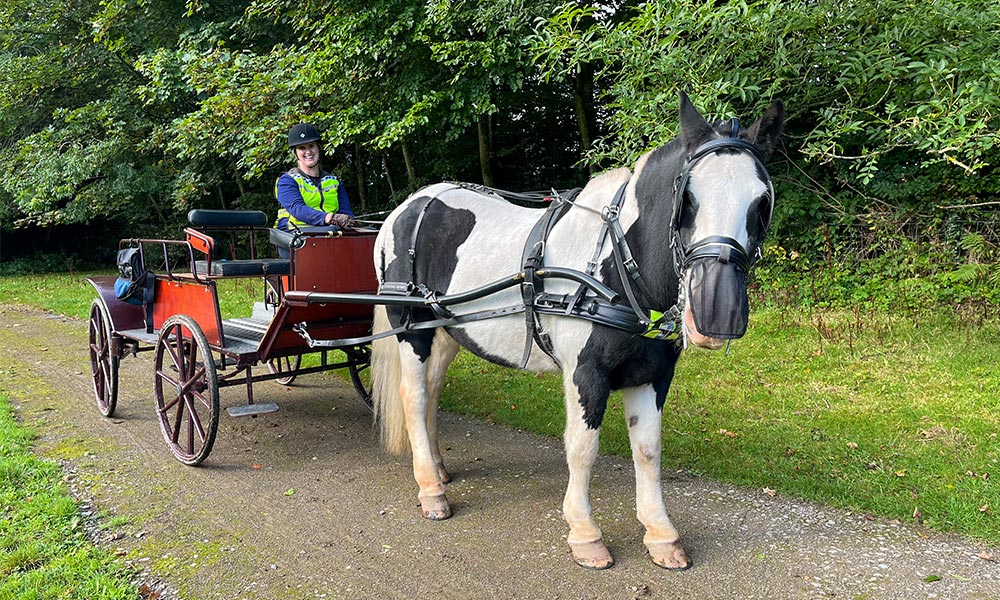
Charlotte and driving a horse-drawn carriage
Remember that any map may not be completely up to date as more recent changes to the Definitive Map may not yet be included. The Definitive Map forms the legal record of public rights of way in England and Wales. They are kept by highway authorities (county councils or unitary authorities) and can be viewed online and at the Map Holder’s office, they show footpaths, bridleways, restricted byway and byways. You can find the Definitive Map by searching online for your county and “Definitive Map”. Local authorities may list other routes on their website, as well as the Definitive Map.
Did you know cyclists should give way to horse riders and walkers on a bridleway?
Finding set horse riding routes
You can find existing routes other horse riders have created in OS Maps, just select ‘find routes’, then ‘horse riding’ as the activity and see ‘all routes’. These routes provide you the route length/time, technical difficulty and rating from other riders and you can filter the results using these. Please note that many of these routes are created by other horse riders and may not have been tried and tested, so research the route in more detail before you head off.
For inspiration about routes to carriage drive check out the BHS Paralympic Legacy Access Project routes.
Top tips for happy riding
- Make sure that your tack fits and is safe.
- Your own clothes and boots should be comfortable and suitable for the weather conditions.
- Wear high-viz, ideally on both you and on the horse.
- Wear boots which are suitable for walking, should it be necessary.
- Take a fully-charged mobile phone and in an unfamiliar area, take a map.
- Tell somebody where you are going and roughly how long you think you will be out.
- Train your horse to open gates safely at home. Allow more time for a gated ride.
- Train your horse to stand, so that if any difficulties arise you can deal with them while the horse is still.
- It is advisable to have a headcollar under the bridle with a rope (looped and knotted – quick release – round the horse’s neck or attached to your saddle).
- If you have never been riding before then try and find a friend to go out with you, company for you and your horse will give you both more confidence when heading out on new routes for the first time.
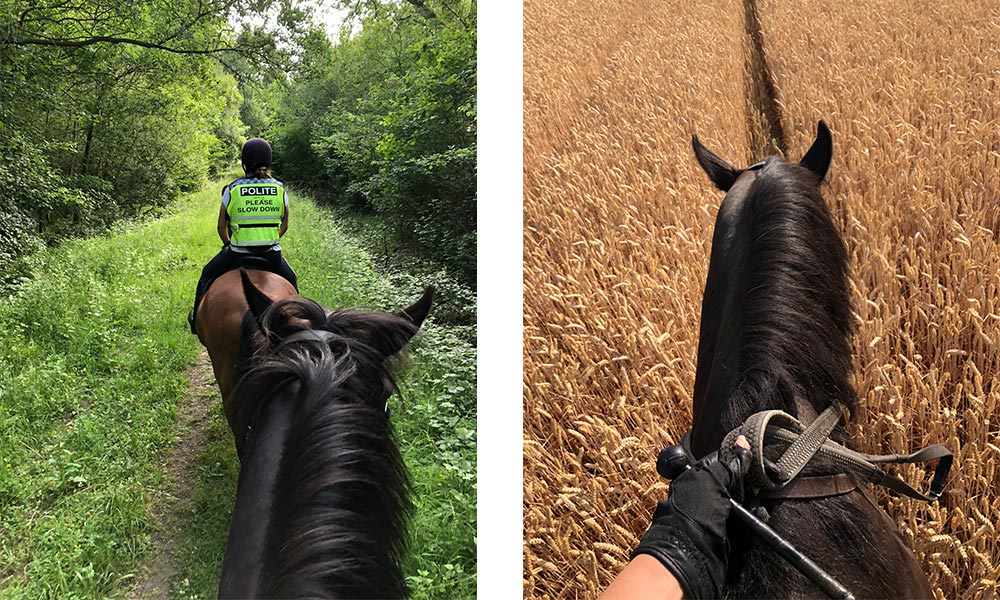
Charlotte riding in Suffolk
What if I don’t have my own horse?
If you don’t have your own horse there are many places you can go to give horse riding a try, have a look for BHS approved riding schools or trekking centres who will provide you with tuition and facilities to experience your first ride. Some of the most spectacular routes for beginners can be found on the UK’s coastline, walking through the sea and the soft sandy beaches are some pretty amazing places to experience your first horse ride.
Our favourite horse riding routes

Latrigg horse riding route – by Charlotte Ditchburn
- Location: Lake District, Cumbria
- Distance: 4.5 miles / 7.22km
- Difficulty: Moderate

Pennine Bridleway horse riding route – by Mairi Olivier
- Location: Nelson, Lancashire
- Distance: 5.5 miles / 8.95km
- Difficulty: Not set


